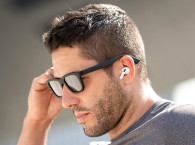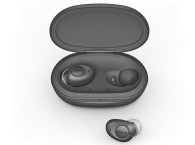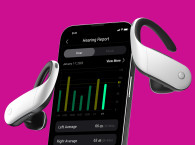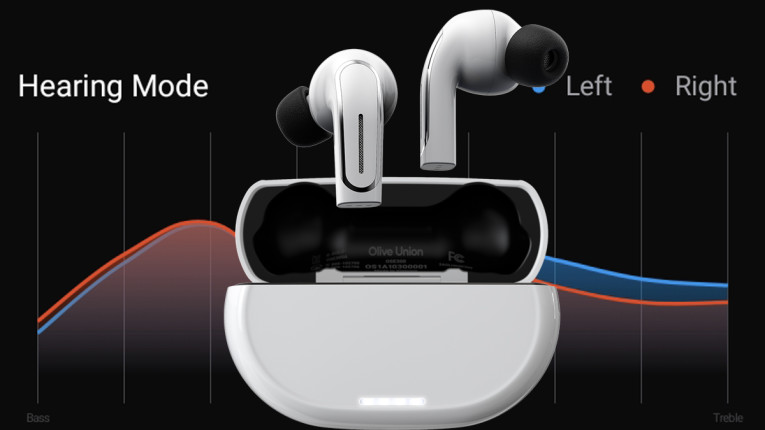
Despite a lack of federal governmental guidance and a confusing tangle of state regulations, several companies have, in this five-year interim, created OTC hearing assistance products that, in essence, repurpose the now-familiar true wireless stereo (TWS) earphone concept for hearing augmentation. After all, a hearing aid is just a microphone, an amplifier, a driver, and some audio signal processing — components found in every set of TWS earphones, which are now a commodity item selling for as little as $20.
One of these companies is Olive Union, which launched its second-generation PSAP, the $299 Olive Pro, in December 2020. The Olive Pro is, in essence, a set of TWS earphones pressed into duty as PSAPs (Photo 1). Like all TWS earphones, they can be used for music listening and phone calls, and they also incorporate active noise cancelling (ANC). But they add an app that offers the user a hearing test, then provides three different hearing enhancement modes (Boost, Clear, and Quiet), which can be set for enhancement levels from 0 to 10.
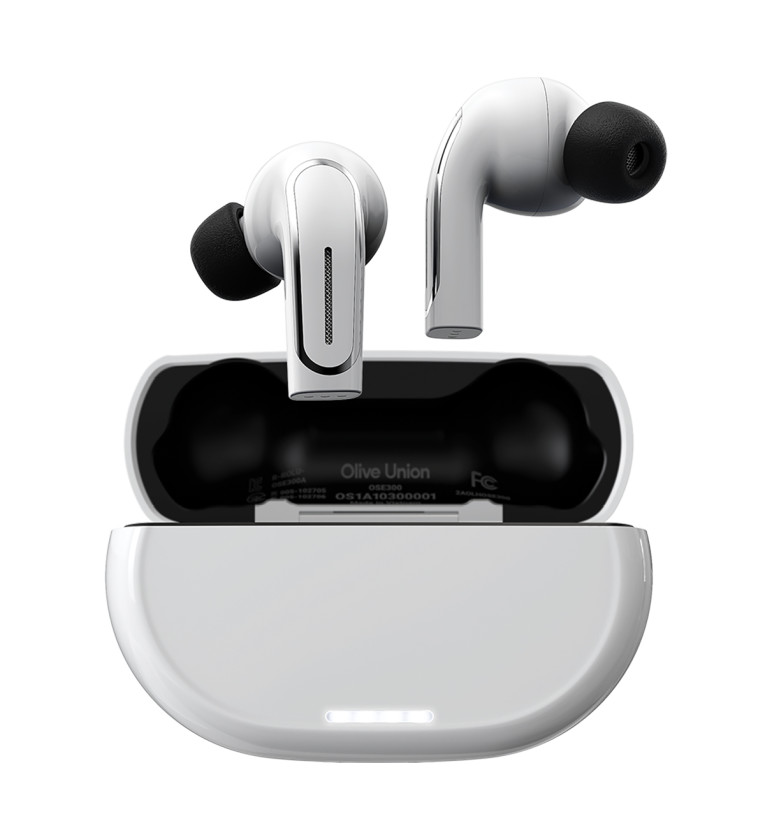
The effect of these modes can be individually fine-tuned for each ear using a 10-band EQ, and the playback response for music listening can be programmed through a separate EQ. Although the Olive Pro can’t be programmed by an audiologist, it’s possible that a sophisticated user could take the results of an audiogram and use those with the EQ to get a more accurate compensation for their hearing loss.
There aren’t a lot of publications reviewing hearing aid products, but still, the Olive Pro got mixed reviews, mostly complaining about the sound quality with music playback. We’d already started digging into an extensive test of the product when, in early fall 2021, the company announced it was pausing sales in the US market. A couple of weeks later, we interviewed some of the company’s executives via Zoom to find out why they hit pause, and what the future of the company looks like.
This article will share our findings about the current version of the Olive Pro, along with the company’s initial vision for the product, its plans for future operations in the US, and its analysis of the current state of the hearing aid and PSAP markets.
The PSAP Challenge
The idea behind Olive Union’s hearing-assistance products is basically the same as that of most competing products, but Olive Union does have its own twist on it. As Chief Technology Officer Yoon Soo framed the challenge, “Eighty percent of the people who could benefit from hearing aids have mild to moderate hearing loss, but the penetration rate — the number of those people actually using hearing aids — is only around 15%. We wondered where that discrepancy is coming from, and our research showed that people who could benefit from hearing aids most often don’t wear them because of usability issues, like getting them to fit right, and having them tuned to deliver a clear benefit. So we decided to make a hearing aid that looks like a Bluetooth earbud, is easy to use like AirPods, and could be used in one ear or two.”
Chief Operating Officer Teo Son added, “We want to make an appealing product that they’ll want to wear, instead of one they’ll be reluctant to wear. We think the Olive Pro is a perfect example of the hearing aids that the U.S. Food and Drug Administration [FDA] wants to make available over-the-counter.”
In my discussion with Olive Union, it became clear that the company’s unique selling prospect — in what has already become a crowded field — is to offer a “just right” amount of user options, enough that users can customize the product’s response to their needs and tastes, but not enough that they become intimidated or need to understand the technical aspects of the product.
As Soo put it, “High-end hearing aids have different frequency bands that can be tuned, and they place a lot of emphasis on custom tuning by an audiologist. With personal sound amplification products such as the Nuheara [reviewed in the July 2021 audioXpress], you get just a few modes, like drive, outdoor, etc., and you can’t really go in and tune the frequency bands and the gain level. We wanted to include as many custom tuning features as possible, not just gain but also attack and release for the compression. We wanted to offer them those adjustments in a way that they’re easy to use and the customer doesn’t have to understand the technical aspects of it.”
Some of these features are already built into the app, such as the ability to equalize the sound differently for music playback than for hearing assistance, using a graphic equalizer. According to the US team lead Nicholas Dahl, “We are working on an update for late 2021 that will give you more controls, such as custom-tuning the gain level. We plan to use more parameters that a layman can understand. They don’t understand attack and release, but they do understand things like noise, treble, bass, and speech clarity. So we give them controls for these parameters, but underneath all that we change the attack, release, and ratio of the compressor.”
During our talk, the Olive Union execs stressed the need for the features included on a PSAP to deliver an obvious, easily demonstrable benefit, so that users can be confident it’s working and more likely to appreciate what the device can do for them. Son noted this principle when I asked him why the Olive Pro doesn’t include a directional focus feature, which many current PSAPs offer. “We have the technology to include directional pickup, but like I saw you found when you tested the Nuheara IQbuds2 Max for audioXpress, most of those only give you a few decibels of boost on sounds coming from the front,” he said. “We have been able to push this to around 7dB to 8dB, but our marketing team was expecting more like 12dB, so they weren’t satisfied with the results we got and they decided not to go ahead with it for now.”
What the company discovered, though, is that the PSAP market introduces problems engineering and product planning can’t solve. “I think the audio engineering wasn’t as big a challenge as the ergonomics. There are a lot of expectations when people buy hearing aids,” Soo said.
The Problems
PSAPs have been around for several years, incorporating increasingly advanced technology while becoming sleeker and stealthier, but none of them appears to have been a major success. Indeed, while we were preparing this article, the company decided, on a temporary basis, to stop selling its product in the North American market. I was curious to find out why, considering that some of the complaints about performance that I’d read in early reviews had already been addressed in updates to the app.
Dahl said that the company’s actions weren’t due to engineering difficulties or product flaws. “We decided to pause sales in North America because even though we’ve done a lot to make this product user-friendly and easy to set up, we found many customers still need help with the product,” he said. “So we’re building up our customer support operations now, with a 24-hour call center for US customers, and I think we will be able to relaunch the product toward the end of 2021. Having the call centers will also give us a lot more feedback from customers, which will help us improve the product.”
According to Olive Union execs — and to every one of the many audiologists I’ve interviewed in the past two years—the biggest problem with hearing aids and PSAPs is that they initially feel and sound strange, because in the process of trying to correct for flaws in the listener’s hearing, they present sound in a very different way than that to which the user has become accustomed.
“Glasses work instantly — you can see the benefit right away,” Soo pointed out. “But hearing aids aren’t effective right away — you have to get accustomed to them, and they may need some further tuning beyond what’s achieved automatically through the hearing test in the app. We — and the rest of the industry, too — need to do a better job of explaining to customers what the hearing aid process is going to be like.”
The Product — and Specifically the App
I got the chance to spend a couple of months using the Olive Pro PSAPs, and to run an extensive set of measurements to gauge the product’s performance and see where there’s room for improvement.
As with most PSAPs, the Olive Pro’s app is probably more important and interesting than the hardware (Photo 2). After you’ve installed the My Olive app, a screen appears that shows the average level of external sound coming through to your eardrums, and the average level of your music listening — both good things to know if you’re concerned about your hearing. It even shows you a graph that tracks your listening levels day-to-day (Figure 1). In my opinion, every app included with every set of Bluetooth headphones should include this feature, because the volume setting on the device is known, the gain of the amp and the sensitivity of the driver are known, and the average level of the content can easily be gauged, so the SPL can be known with reasonable and useful accuracy.
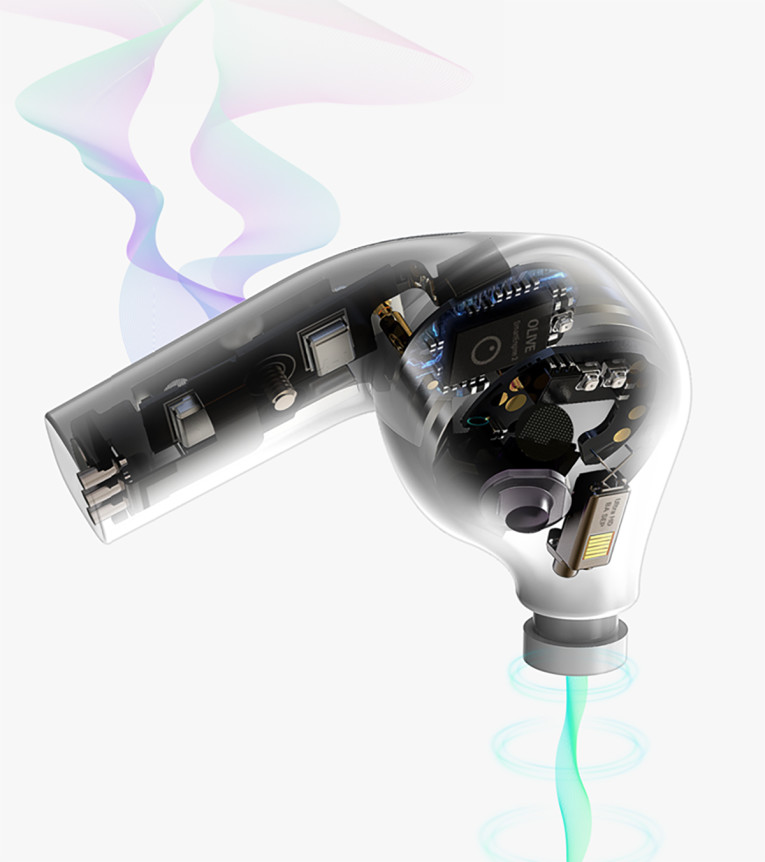
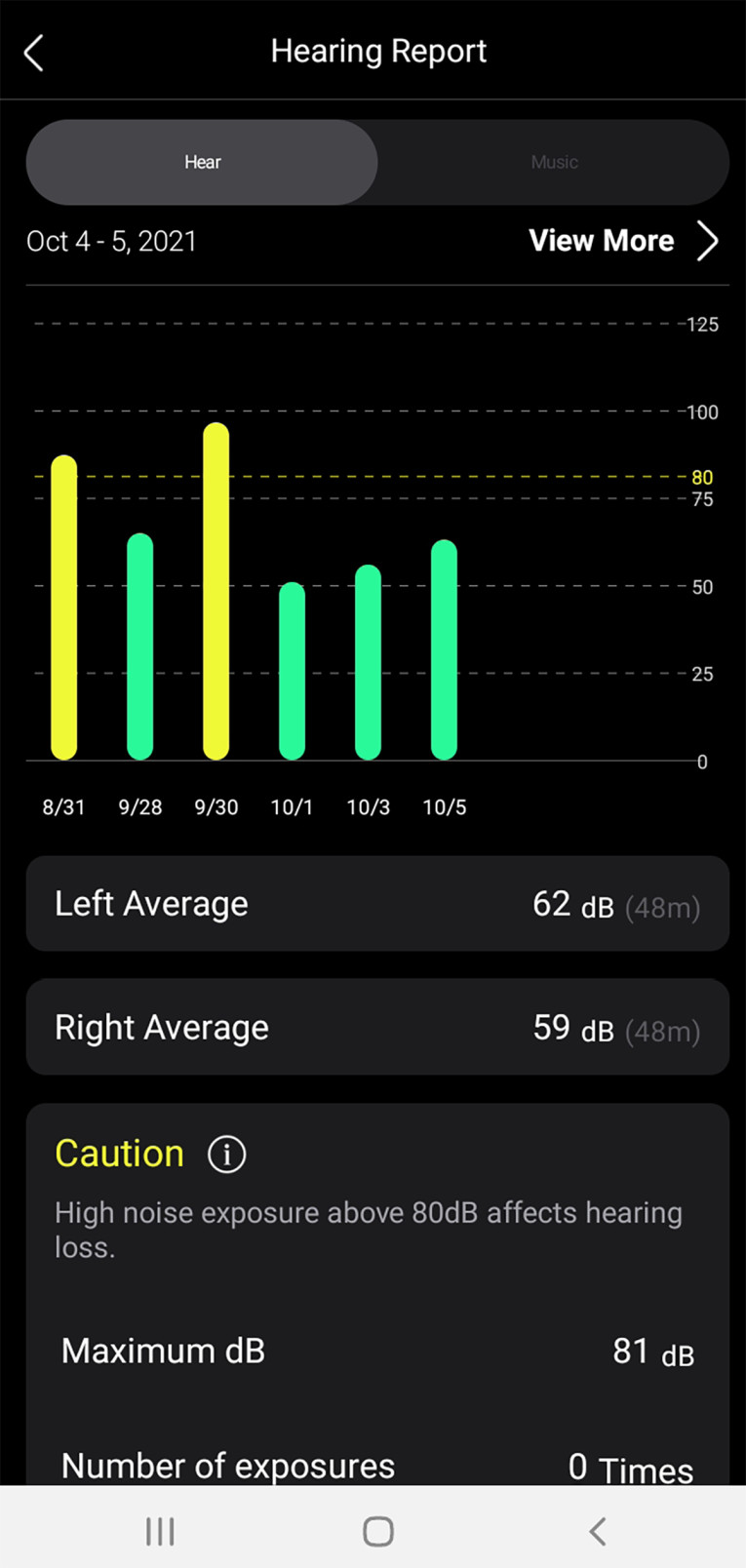
A screen below these meters prompts you to optimize the Olive Pro’s performance using a five-minute hearing test to create what the company calls a HearID. Like most hearing tests included with PSAPs, this one plays a certain frequency in one of your ears at a moderate level, then backs off the level in steps of several decibels, and asks you to press an onscreen button when you hear the tone again. Unfortunately, the time between the tones is always the same, and I found that I sometimes reflexively anticipated the next tone, pushing the button even if I wasn’t sure I heard the tone. This is a problem that medical hearing tests take care to avoid.
Regardless, the test seemed to profile my hearing fairly accurately. Once the test is done, it shows a graph (Figure 2) similar to what you’d get from an audiologist, detailing the sensitivity of your hearing in each ear across most of the audio range. Unfortunately, this graph is not labeled with frequency or decibel information, so its representation is unnecessarily abstract — but it does look much like the results of my most recent hearing evaluation, conducted in the process of my February 2021 audioXpress review of the Widex Moment hearing aids.

As noted previously, the app gives you extensive control over the hear-through (hearing enhancement) function, noise cancelling, and music playback (Figure 3). When you click on one of the hear-through modes, a frequency response plot shows a combination of the hearing correction it has applied (based on your hearing test results) in each channel, the transfer function of the listening mode you’ve chosen, and the hearing EQ settings you’ve added, so you can always see exactly what the Olive Pro is doing. At least for users who have some basic comprehension of audio, this should be a big help in allowing them to tune the product to suit their needs.

I found all of the controls and functions intuitive to use. The app has an integral user guide to guide you through the operations, but I doubt you’ll need it.
Listening
Fortunately, my hearing loss is typical for my age (59) and gender, so I don’t really need hearing correction, but having evaluated and measured one hearing aid and several PSAPs, I have a decent understanding of what these products are supposed to do.
With three different hear-through modes, separate EQ for each ear, and adjustable compensation level, it’s tough to characterize what the Olive Pro does, and in some ways, it’s tough to criticize — because if there’s something you don’t like about what it’s doing, there’s a good chance you can correct it, at least to some extent, through the controls. (Although there’s one exception, which we’ll address shortly.)
Of the three modes — Boost, Clear, and Quiet — Boost had the most dramatic and useful effect, thanks to a large peak in the lower treble. However, it adds a lower midrange boost (perhaps intended to aid music listening) that adds a persistent “whooshing” sound. I was able to get rid of this effect by turning down the bass and lower mids. The Clear mode simply elevated the treble, while the Quiet mode only boosted the lower treble. I spent a lot of time in a lot of different settings with the Olive Pro, listening for how it enhanced voices, and I found that none of the presets achieved the clarity enhancement I’ve gotten with the best PSAPs—unless I applied my own EQ.
After some experimentation, I got it to the point where I heard a substantial increase in voice clarity. For example, I was watching a kids’ football coach at a distance of perhaps 25 meters, and without the Olive Pros, I could just make out the calls he was shouting. With my custom EQ setting, and the enhancement cranked up to 8, 9, or 10, it was easy to hear and understand the calls — the Olive Pro felt almost like a “sonic telescope,” even though it lacks a directional pickup function.
Music listening through the Olive Pro was OK. To me, the sound was comparable to that of typical inexpensive wired earphones — listenable, but lacking in detail and depth. I was able to improve on this with the music EQ in the Settings menu — using the Bass Boost mode with a little extra lower treble added — but I never got sound that really impressed me.
Soo told me that the company didn’t tune the Olive Pro to any specific response, such as the Harman curve, and that the engineers sought “a natural balance of bass to treble.” He pointed out that the app gives listeners the power to tune the sound to their liking — and maybe for PSAPs, where the listeners will have a widely varying degree of hearing loss, likely including “noise notches” in the upper midrange and lower treble and different levels of loss in each ear, tuning for a certain ideal response doesn’t make much sense.
The thing that really bothered me about the Olive Pro’s performance is its latency. All hearing aids and PSAPs have some latency, which if it’s long enough, can create two problems. First is echo, as you hear the direct sound leaking through the ear tips or bone conduction, followed by the processed sound, sometimes many milliseconds later. Second is the weirdness of seeing your hand click, say, a knife against a cutting board, and having what arrives at your ears lag noticeably behind what arrives at your eyes — much like experiencing a lip-sync problem when watching a digital TV broadcast.
Although the Olive Pro’s measured latency varied greatly from one trial to the next, the latency was always high enough to create the echo effect. It reminded me of some old rock recordings, such as the famous drum sound from Led Zeppelin’s “When the Levee Breaks,” which thickened the beats with slapback echo from a Binson Echorec magnetic echo machine. I could hear a little bit of this effect when I tested the Nuheara IQbuds2 Max, but it was never enough to bother me.
I tried the noise cancelling function at home, with pink noise playing through speakers, and on a jet airplane trip from Los Angeles, CA, to Seattle, WA.
I heard very little noise reduction when the cancellation was activated, and only a slight difference between the different noise cancelling modes.
Measurements
I performed measurements using a GRAS RA0402 high-resolution ear simulator/coupler (Photo 3). For latency measurements, I used an Audiomatica Clio 12 QC audio analyzer, feeding signals into the Olive Pro via a Reiyin WT-04 USB Bluetooth adapter. For all other measurements, I used the RA0402 with an M-Audio Mobile Pre USB interface running TrueRTA software. (Incidentally, Olive Union uses a standard 711 coupler, which is like the RA0402 but has a much stronger ear canal resonance—typically around 13kHz—but it is dependent on the device under test.)

The latency of the Olive Pro jumped around sporadically — measurement-to-measurement variation on the order of 10ms to 30ms is common with true wireless earphones, but with the Olive Pro, it was sometimes as low as 10ms, but occasionally ran longer than 300ms. Thus, I was unable to set the Clio’s gating to compensate for the latency. For this reason, I had to use pink noise with the TrueRTA spectrum analyzer to do the frequency response measurements. I cannot recall seeing such large variations in latency with any Bluetooth headphones or earphones I’ve measured, although based on my listening, I have to think the 300ms figure is more representative of this product’s performance.
The Olive Pro’s “native” frequency response — with no hearing correction applied — for music playback is shown along with the responses for the JBL Club Pro+ and Status Audio Between Pro true wireless earphones (Figure 4). The Olive Pro’s frequency response shows flatter output than the others, but with headphones, a flat response suggests a headphone will sound midrange-heavy. It also shows more output between 100Hz and 300Hz than the others, and much less output in the treble and upper midrange, above about 1kHz. This doesn’t suggest particularly good sound, but of course, the app can compensate with the 10-band EQ, the Special EQ settings to compensate for hearing loss (Figure 5), and the three different Basic EQ music listening presets (Figure 6).
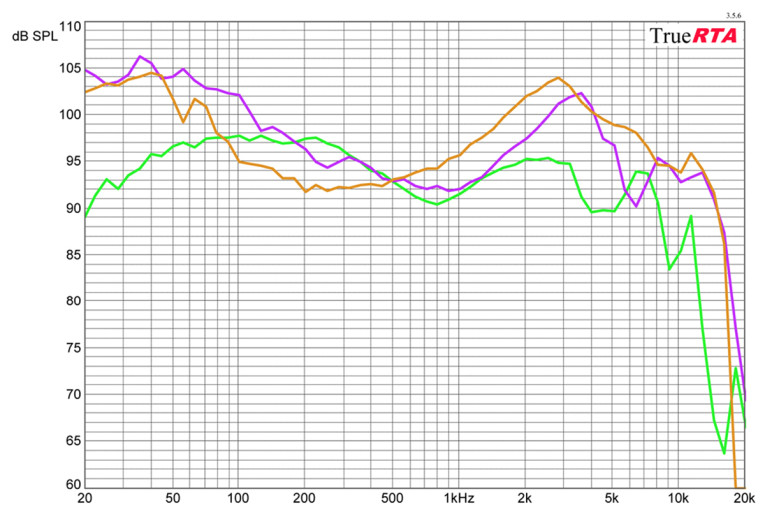


The transfer function of the hear-through modes (Figure 7), measured here at maximum boost with pink noise at a base SPL of 60dB, is fairly typical for a PSAP, with a boost focused between 300Hz and 4kHz. Maximum boost occurs in Boost mode, with peak amplification of 36dB centered at 650Hz.
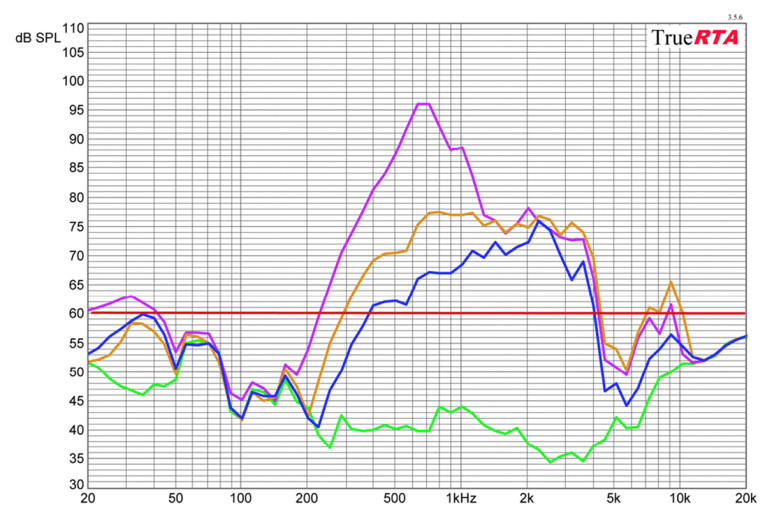
Compression — raising the level of critical frequencies while applying a limiter to them, so they’re always heavily boosted—is a standard feature of hearing aids. To profile the characteristics the Olive Pro’s compression function (Figure 8), I started in the Boost mode at a baseline uncorrelated external noise level of 60dB SPL, and raised the noise level in the room by 5dB increments to a maximum of 90dB SPL. As you can see, compression is highest between about 300Hz and 2kHz, where the 30dB signal level increase yields an output increase of only 10dB, for a compression ratio of roughly 3:1. There’s little or no compression in the bass, and compression in the treble didn’t kick in until the level got louder than 70dB.

To measure isolation — and in particular, the effect of the noise cancelling — I played uncorrelated pink noise at 85dB SPL through a six-speaker system and used TrueRTA to see how much sound leaked through at each frequency (Figure 9). There was little measured improvement with noise cancelling activated.

Conclusion
Over the course of the last two years, I’ve spoken with numerous audiologists, hearing experts, and manufacturers of hearing aids and PSAPs. Yet, I still feel we’re all groping around in the dark. There’s little consumer research we can tap, and very few in-depth reviews we can consult or use as a paradigm. And while there are predictable patterns to hearing loss, everyone’s hearing loss is different, and as Olive Union’s execs noted, emotional issues and often-unrealistic user expectations make it hard to speculate about what hearing aid or PSAP will work well for which person (Photo 4).
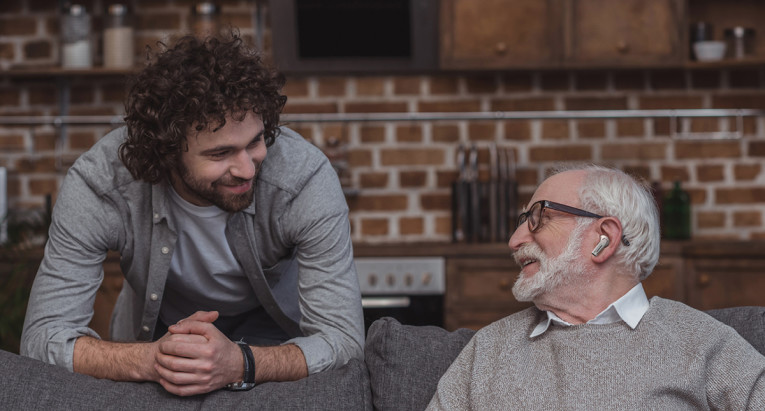
That said, I think the Olive Pro has enough power and flexibility to help many people who suffer hearing loss — but not enough hearing loss that they want to spend thousands of dollars on audiologist-fitted hearing aids. However, I expect the latency in the product’s processing will bother many users, and I wonder how many of the people in the demographic most likely to experience hearing loss will have the knowledge and the patience to get the Olive Pro dialed in for their ears. But of course, this product, like all app-driven PSAPs, is a work in progress, and Olive Union anticipates that it may make some changes to the app — and thus, the Olive Pro’s functionality — once the FDA has settled on a firm set of guidelines.
This article was originally published in audioXpress, January 2022.
 About the Author
About the AuthorBrent Butterworth has worked as an audio journalist and technical consultant since 1989. He currently writes for Wirecutter, SoundStage, and JazzTimes, and has published speaker, headphone, and amplifier measurements in audioXpress, Sound & Vision, Home Theater, Home Theater Review, and many other publications. He has also served as a consultant on measurement, design, and tuning of audio products, with a special focus on active speakers and DSP tuning.




